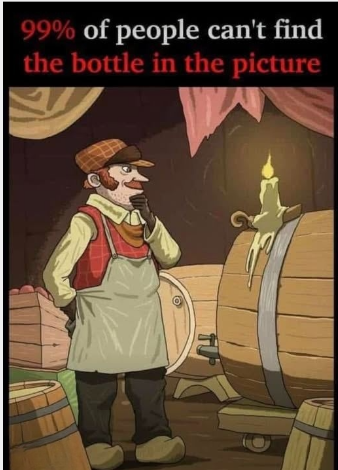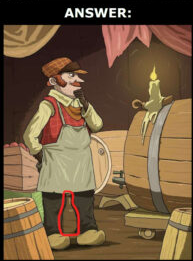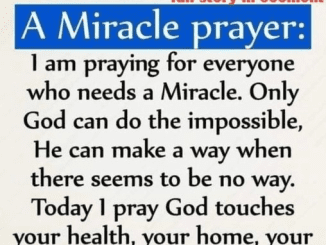Are you ready for a fun and surprisingly tricky brain teaser? At first glance, this puzzle looks simple. It shows a man standing in a rustic wine cellar, surrounded by barrels, wooden crates, and a lit candle. But somewhere in this picture, a hidden bottle is cleverly disguised. Your mission: find it without checking the answer below.
Sounds easy? Think again.
This puzzle has gone viral for a reason—most people miss the bottle on their first few tries. It’s a clever play on visual perception and how our brain interprets complex images. So take your time, scan the image closely, and ask yourself: Where would an artist hide a bottle in plain sight?
Why So Many People Miss the Hidden Bottle

Visual brain teasers like this rely on one thing: misdirection. The artist fills the scene with familiar objects—barrels, shadows, lighting—and your brain filters the image based on what it expects to see. That’s exactly why so many people fall into these common traps:
First, your attention naturally goes to the surroundings. You look at the barrels, the background, and maybe behind the furniture. You assume the bottle must be hiding behind something or tucked away in a corner.
Second, your brain focuses on the “obvious bottle shape”—a neck and a rounded base. But in this image, the bottle isn’t outlined clearly, and it doesn’t stand out by color or contrast. Instead, it’s hidden in negative space, making it easy to overlook.
And third, many people don’t examine the human figure closely enough. Your brain treats the person as the “main subject,” not a hiding spot. That’s exactly the mistake the artist is counting on.
Common Mistakes Solvers Make
If you didn’t spot the bottle right away, don’t worry. You’re not alone. Here are the most common reasons people struggle with puzzles like this:
They scan too quickly. Our eyes tend to jump from one area to the next without slowing down to examine details.
They ignore outlines. This puzzle uses negative space—areas around objects—to create a hidden shape.
They assume it must be in the background. The brain tries to find objects in clutter, but sometimes the answer is hidden right in front of you, within the main character.
They don’t rotate their perspective. Sometimes changing the way you look at something—tilting your head, zooming in, or flipping the image—can reveal the solution.
Video : Can You Spot the Hidden Bottle? 🔍 Most People Miss It!
Step-by-Step Guide to Finding the Hidden Bottle
Let’s solve this together. Follow these steps and you’ll soon see what your eyes may have missed.
Start by looking at the background. Check the barrels, candle, and crates. You won’t find anything obvious there. That’s the artist’s trick—to make you look everywhere but the right spot.
Now focus on the man in the center of the image. He seems innocent enough—just standing there in his apron, deep in thought. But now look at his legs. Specifically, the shadowy space between his legs.
Take a closer look at the black area between his pants and apron. Notice the curves? The outline? That’s right—the bottle is hidden in the negative space formed by his pants and apron.
It’s shaped perfectly: a narrow neck, a rounded body, and a base that lines up with the floor. The artist has seamlessly blended it into the figure’s form, so unless you’re looking specifically for outlines, you’ll likely miss it.
Why This Puzzle is a Great Exercise for Your Brain
Puzzles like this are more than just fun—they’re powerful tools to train your mind. Here’s what they help improve:
They boost attention to detail. You learn to slow down and actually observe.
They strengthen visual memory. Spotting patterns helps your brain remember visual cues more effectively.
They improve lateral thinking. You’re forced to think outside the box and question assumptions.
They build patience. The answer isn’t always immediate, but persistence pays off.
These skills don’t just help you solve puzzles—they also come in handy in real-life situations, like solving problems at work, noticing small errors, or thinking creatively.
So, Did You Find It Before Seeing the Answer?
Be honest—how long did it take you to spot the bottle? Did you search the barrels first? Did your eyes keep missing that dark shadow between the man’s legs? Don’t worry if it took a while. That’s the beauty of visual puzzles—they challenge how we think and force us to observe from new angles.

If you found it right away, congratulations! You’ve got a sharp eye and strong pattern recognition. If it took you a little longer, no problem—you’ve just trained your brain a bit more today.
Join the Challenge and Share Your Results
Now it’s your turn to keep the fun going. Drop a comment and let us know how long it took you to find the bottle. Better yet, share the image with your friends and see how fast they spot it. Can they find it without hints?
Visual puzzles are always more fun when they’re shared. You’ll be surprised how many people will say, “I looked at this for five minutes and didn’t see it!”
Video : Find The Hidden Object In Picture
Try More Puzzles and Keep Sharpening Your Mind
If you enjoyed this challenge, don’t stop here. Spot-the-object puzzles, optical illusions, and brain teasers are a great way to keep your brain active. Make them part of your daily routine—even a few minutes a day can help improve your focus, creativity, and problem-solving abilities.
So, next time someone shows you a “simple” image and says, “Can you find the bottle?”—you’ll smile, pause, and look at the shadows. Because now you know: sometimes, the answer is hidden in the space you least expect.


